当前位置:
X-MOL 学术
›
Comput. Animat. Virtual Worlds
›
论文详情
Our official English website, www.x-mol.net, welcomes your feedback! (Note: you will need to create a separate account there.)
Deep boundary-aware semantic image segmentation
Computer Animation and Virtual Worlds ( IF 1.1 ) Pub Date : 2021-05-24 , DOI: 10.1002/cav.2023 Huisi Wu 1 , Yifan Li 1 , Le Chen 1 , Xueting Liu 1 , Ping Li 2
Computer Animation and Virtual Worlds ( IF 1.1 ) Pub Date : 2021-05-24 , DOI: 10.1002/cav.2023 Huisi Wu 1 , Yifan Li 1 , Le Chen 1 , Xueting Liu 1 , Ping Li 2
Affiliation

|
While extensive research efforts have been made in semantic image segmentation, the state-of-the-art methods still suffer from blurry boundaries and mismatched objects due to the insufficient multiscale adaptability. In this paper, we propose a two-branch convolutional neural network (CNN) approach to capture the multiscale context and the boundary information with the two branches, respectively. To capture the multiscale context, we propose to embed self-attention mechanism to the atrous spatial pyramid pooling network. To capture the boundary information, we propose to fuse the low-level features in boundary feature extraction for refining the extracted boundaries via a feature fusion layer (FFL). With FFL, our method can improve the segmentation result with clearer boundaries. A new loss function is proposed which contains a segmentation loss and a boundary loss. Experiments show that our method can predict the boundaries of objects more clearly and have better performance for small-scale objects.
中文翻译:

深度边界感知语义图像分割
尽管在语义图像分割方面进行了广泛的研究,但由于多尺度适应性不足,最先进的方法仍然存在边界模糊和对象不匹配的问题。在本文中,我们提出了一种两分支卷积神经网络 (CNN) 方法,分别用两个分支捕获多尺度上下文和边界信息。为了捕捉多尺度上下文,我们建议将自注意力机制嵌入到多孔空间金字塔池化网络中。为了捕获边界信息,我们建议在边界特征提取中融合低级特征,以通过特征融合层(FFL)细化提取的边界。使用 FFL,我们的方法可以改善边界更清晰的分割结果。提出了一种新的损失函数,其中包含分割损失和边界损失。实验表明,我们的方法可以更清晰地预测物体的边界,对小规模物体有更好的性能。
更新日期:2021-07-12
中文翻译:

深度边界感知语义图像分割
尽管在语义图像分割方面进行了广泛的研究,但由于多尺度适应性不足,最先进的方法仍然存在边界模糊和对象不匹配的问题。在本文中,我们提出了一种两分支卷积神经网络 (CNN) 方法,分别用两个分支捕获多尺度上下文和边界信息。为了捕捉多尺度上下文,我们建议将自注意力机制嵌入到多孔空间金字塔池化网络中。为了捕获边界信息,我们建议在边界特征提取中融合低级特征,以通过特征融合层(FFL)细化提取的边界。使用 FFL,我们的方法可以改善边界更清晰的分割结果。提出了一种新的损失函数,其中包含分割损失和边界损失。实验表明,我们的方法可以更清晰地预测物体的边界,对小规模物体有更好的性能。



























 京公网安备 11010802027423号
京公网安备 11010802027423号